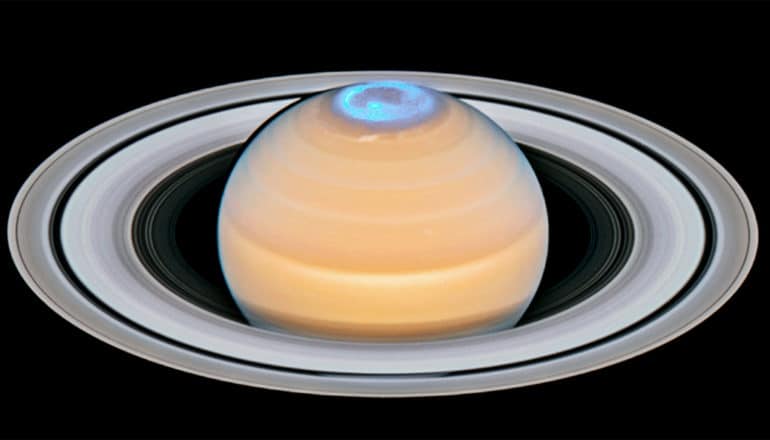
Auroras at Saturn’s north and south poles may account for why the planet’s upper atmosphere is so hot, researchers say.
The upper layers in the atmospheres of Saturn—and the other gas giants Jupiter, Uranus, and Neptune—are hot, just like Earth’s. But unlike Earth, the sun is too far from these outer planets to account for the high temperatures.
Their heat source one of the great mysteries of planetary science.
The new analysis of data from NASA’s Cassini spacecraft may also offer a viable explanation for the temperature on the other gas giants.
Electric currents, which interactions between solar winds and charged particles from Saturn’s moons trigger, spark the auroras and heat the upper atmosphere. As with Earth’s northern lights, studying auroras tells scientists what’s going on in the planet’s atmosphere.
The work in Nature Astronomy is the most complete mapping yet of both temperature and density of a Saturn’s upper atmosphere—a region scientists have poorly understood.
“Understanding the dynamics really requires a global view,” says lead author Zarah Brown, a graduate student in the University of Arizona Lunar and Planetary Laboratory. “This dataset is the first time we’ve been able to look at the upper atmosphere from pole to pole while also seeing how temperature changes with depth.”
By building a complete picture of how heat circulates in the atmosphere, scientists are better able to understand how auroral electric currents heat the upper layers of Saturn’s atmosphere and drive winds.
The global wind system can distribute this energy, which is initially deposited near the poles toward the equatorial regions, heating them to twice the temperatures expected from the sun’s heating alone.
“The results are vital to our general understanding of planetary upper atmospheres and are an important part of Cassini’s legacy,” says coauthor Tommi Koskinen, a member of Cassini’s Ultraviolet Imaging Spectograph team.
“They help address the question of why the uppermost part of the atmosphere is so hot, while the rest of the atmosphere—due to the large distance from the sun—is cold.”
Managed by NASA’s Jet Propulsion Laboratory in Southern California, Cassini was an orbiter that observed Saturn for more than 13 years before exhausting its fuel supply.
The mission plunged it into the planet’s atmosphere in September 2017, in part to protect its moon Enceladus, which Cassini discovered might hold conditions suitable for life. But before its plunge, Cassini performed 22 ultra-close orbits of Saturn, a final tour called the Grand Finale.
It was during the Grand Finale that it collected the key data for the new temperature map of Saturn’s atmosphere. For six weeks, Cassini targeted several bright stars in the constellations of Orion and Canis Major as they passed behind Saturn.
As the spacecraft observed the stars rise and set behind the giant planet, scientists analyzed how the starlight changed as it passed through the atmosphere.
Measuring the density of the atmosphere gave scientists the information they needed to find the temperatures. Density decreases with altitude, and the rate of decrease depends on temperature. They found that temperatures peak near the auroras, indicating that auroral electric currents heat the upper atmosphere.
Density and temperature measurements together helped scientists figure out wind speeds. Understanding Saturn’s upper atmosphere, where planet meets space, is key to understanding space weather and its impact on other planets in our solar system and exoplanets around other stars.
“Even though thousands of exoplanets have been found, only the planets in our solar system can be studied in this kind of detail. Thanks to Cassini, we have a more detailed picture of Saturn’s upper atmosphere right now than any other giant planet in the universe,” Brown says.
The Cassini-Huygens mission is a cooperative project of NASA, the European Space Agency and the Italian Space Agency. NASA’s Jet Propulsion Laboratory, or JPL, a division of Caltech in Pasadena, manages the mission for NASA’s Science Mission Directorate in Washington. JPL designed, developed, and assembled the Cassini orbiter.
Source: University of Arizona
The post Team solves mystery of Saturn’s hot atmosphere appeared first on Futurity.
from Futurity https://ift.tt/34zKBxv
No comments:
Post a Comment